Floodplain
A floodplain or flood plain or flood-plain is an area of land adjacent to a stream or river which stretches from the banks of its channel to the base of the enclosing valley walls, and which experiences flooding during periods of high discharge.[1] The soils usually consist of clays, silts, and sands deposited during floods.
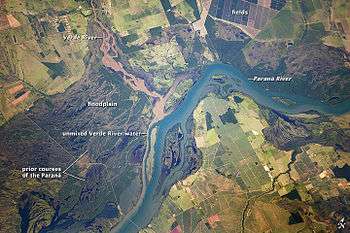
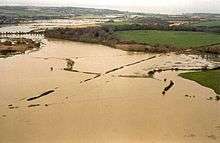
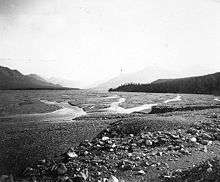
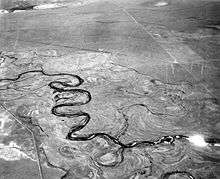
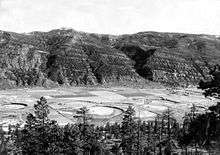
Formation
Floodplains are formed when a meander erodes sideways as it travels downstream. When a river breaks its banks, it leaves behind layers of alluvium (silt). These gradually build up to create the floor of the plain. Floodplains generally contain unconsolidated sediments, often extending below the bed of the stream. These are accumulations of sand, gravel, loam, silt, and/or clay, and are often important aquifers, the water drawn from them being pre-filtered compared to the water in the river.
Geologically ancient floodplains are often represented in the landscape by fluvial terraces. These are old floodplains that remain relatively high above the present floodplain and indicate former courses of a stream.
Sections of the Missouri River floodplain taken by the United States Geological Survey show a great variety of material of varying coarseness, the stream bed having been scoured at one place and filled at another by currents and floods of varying swiftness, so that sometimes the deposits are of coarse gravel, sometimes of fine sand or of fine silt. It is probable that any section of such an alluvial plain would show deposits of a similar character.
The floodplain during its formation is marked by meandering or anastomotic streams, oxbow lakes and bayous, marshes or stagnant pools, and is occasionally completely covered with water. When the drainage system has ceased to act or is entirely diverted for any reason, the floodplain may become a level area of great fertility, similar in appearance to the floor of an old lake. The floodplain differs, however, because it is not altogether flat. It has a gentle slope downstream, and often, for a distance, from the side towards the center.
The floodplain is the natural place for a river to dissipate its energy. Meanders form over the floodplain to slow down the flow of water and when the channel is at capacity the water spills over the floodplain where it is temporarily stored. In terms of flood management the upper part of the floodplain (piedmont zone) is crucial as this is where the flood water control starts. Artificial canalisation of the river here will have a major impact on wider flooding. This is the basis of sustainable flood management.
Ecology
Floodplains can support particularly rich ecosystems, both in quantity and diversity. Tugay forests form an ecosystem associated with floodplains, especially in Central Asia. They are a category of riparian zones or systems. A floodplain can contain 100 or even 1,000 times as many species as a river. Wetting of the floodplain soil releases an immediate surge of nutrients: those left over from the last flood, and those that result from the rapid decomposition of organic matter that has accumulated since then. Microscopic organisms thrive and larger species enter a rapid breeding cycle. Opportunistic feeders (particularly birds) move in to take advantage. The production of nutrients peaks and falls away quickly; however the surge of new growth endures for some time. This makes floodplains particularly valuable for agriculture. River flow rates are undergoing change following suit with climate change. This change is a threat to the riparian zones and other floodplain forests. These forests have over time synced their seedling deposits after the spring peaks in flow to best take advantage of the nutrient rich soil generated by peak flow. [2]
Excluding famines and epidemics, some of the worst natural disasters in history (measured by fatalities) have been river floods, particularly in the Yellow River in China – see list of deadliest floods. The worst of these, and the worst natural disaster (excluding famine and epidemics) were the 1931 China floods, estimated to have killed millions. This had been preceded by the 1887 Yellow River flood, which killed around one million people, and is the second-worst natural disaster in history.
The extent of floodplain inundation depends in part on the flood magnitude, defined by the return period.
In the United States the Federal Emergency Management Agency (FEMA) manages the National Flood Insurance Program (NFIP). The NFIP offers insurance to properties located within a flood prone area, as defined by the Flood Insurance Rate Map (FIRM), which depicts various flood risks for a community. The FIRM typically focuses on delineation of the 100-year flood inundation area, also known within the NFIP as the Special Flood Hazard Area.
Where a detailed study of a waterway has been done, the 100-year floodplain will also include the floodway, the critical portion of the floodplain which includes the stream channel and any adjacent areas that must be kept free of encroachments that might block flood flows or restrict storage of flood waters. Another commonly encountered term is the Special Flood Hazard Area, which is any area subject to inundation by the 100-year flood.[3] A problem is that any alteration of the watershed upstream of the point in question can potentially affect the ability of the watershed to handle water, and thus potentially affects the levels of the periodic floods. A large shopping center and parking lot, for example, may raise the levels of the 5-year, 100-year, and other floods, but the maps are rarely adjusted, and are frequently rendered obsolete by subsequent development.
In order for flood-prone property to qualify for government-subsidized insurance, a local community must adopt an ordinance that protects the floodway and requires that new residential structures built in Special Flood Hazard Areas be elevated to at least the level of the 100-year flood. Commercial structures can be elevated or flood proofed to or above this level. In some areas without detailed study information, structures may be required to be elevated to at least two feet above the surrounding grade.[4] Many State and local governments have, in addition, adopted floodplain construction regulations which are more restrictive than those mandated by the NFIP. The US government also sponsors flood hazard mitigation efforts to reduce flood impacts. California's Hazard Mitigation Program is one funding source for mitigation projects. A number of whole towns such as English, Indiana, have been completely relocated to remove them from the floodplain. Other smaller-scale mitigation efforts include acquiring and demolishing flood-prone buildings or flood-proofing them.
In some floodplains, such as the Inner Niger Delta of Mali, annual flooding events are a natural part of the local ecology and rural economy, allowing for the raising of crops through recessional agriculture. However, in Bangladesh, which occupies the Ganges Delta, the advantages provided by the richness of the alluvial soil of the floodplain are severely offset by frequent floods brought on by cyclones and annual monsoon rains. These extreme weather events cause severe economic disruption and loss of human life in the densely-populated region.
See also
- Flood-meadow, area of grassland or pasture beside a river, subject to seasonal flooding.
- Water-meadow, area of grassland or pasture beside a river, subject to controlled seasonal flooding.
- Crevasse splay – Sediment deposited on a floodplain by a stream which breaks its levees, sedimentary deposit formed when an overloaded stream breaks its levee.
- Red River Floodway as a good example of a floodway.
- Floodplain restoration
- Flood opening, a technique for mitigating the effects of flooding on structures, mandated in some regions.
References
- Goudie, A. S., 2004, Encyclopedia of Geomorphology, vol. 1. Routledge, New York. ISBN 0-415-32737-7
- Rood, Stewart B.; Pan, Jason; Gill, Karen M.; Franks, Carmen G.; Samuelson, Glenda M.; Shepherd, Anita (2008-02-01). "Declining summer flows of Rocky Mountain rivers: Changing seasonal hydrology and probable impacts on floodplain forests". Journal of Hydrology. 349 (3–4): 397–410. doi:10.1016/j.jhydrol.2007.11.012.
- "44 CFR 59.1 - Definitions". LII / Legal Information Institute.
- "44 CFR 60.3 - Flood plain management criteria for flood-prone areas". LII / Legal Information Institute.
Sources
- Powell, W. Gabe. 2009. Identifying Land Use/Land Cover (LULC) Using National Agriculture Imagery Program (NAIP) Data as a Hydrologic Model Input for Local Flood Plain Management. Applied Research Project, Texas State University. http://ecommons.txstate.edu/arp/296/

External links
![]()